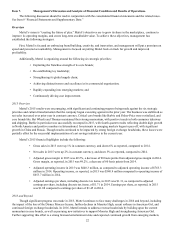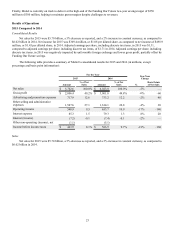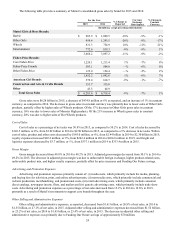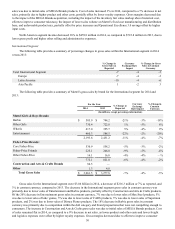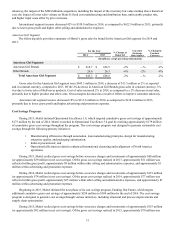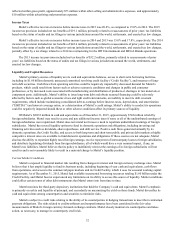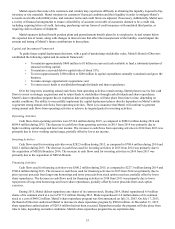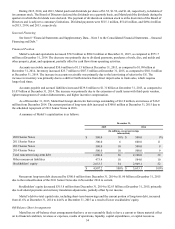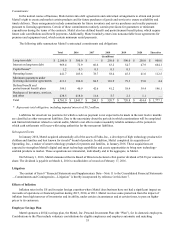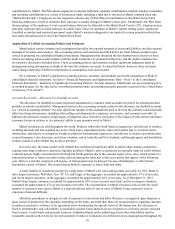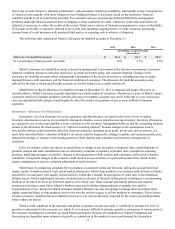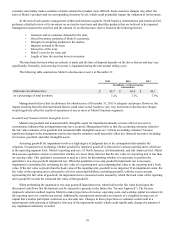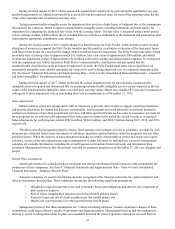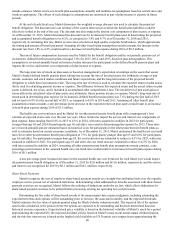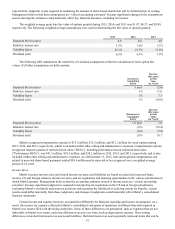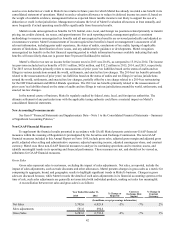Mattel 2015 Annual Report Download - page 36
Download and view the complete annual report
Please find page 36 of the 2015 Mattel annual report below. You can navigate through the pages in the report by either clicking on the pages listed below, or by using the keyword search tool below to find specific information within the annual report.32
reflected within gross profit, approximately $73 million within other selling and administrative expenses, and approximately
$10 million within advertising and promotion expenses.
Income Taxes
Mattel’s effective tax rate on income before income taxes in 2015 was 20.4%, as compared to 15.0% in 2014. The 2015
income tax provision included net tax benefits of $19.1 million, primarily related to reassessments of prior years’ tax liabilities
based on the status of audits and tax filings in various jurisdictions around the world, settlements, and enacted tax law changes.
Mattel’s effective tax rate on income before income taxes in 2014 and 2013 was 15.0% and 17.8%, respectively. The 2014
income tax provision included net tax benefits of $42.6 million, primarily related to reassessments of prior years’ tax liabilities
based on the status of audits and tax filings in various jurisdictions around the world, settlements, and enacted tax law changes,
partially offset by a tax charge related to a 2014 tax restructuring for the HIT Entertainment and MEGA Brands operations.
The 2013 income tax provision included net tax benefits of $32.2 million, primarily related to reassessments of prior
years’ tax liabilities based on the status of audits and tax filings in various jurisdictions around the world, settlements, and
enacted tax law changes.
Liquidity and Capital Resources
Mattel’s primary sources of liquidity are its cash and equivalents balances, access to short-term borrowing facilities,
including its $1.60 billion domestic unsecured committed revolving credit facility (“Credit Facility”), and issuances of long-
term debt securities. Cash flows from operating activities could be negatively impacted by decreased demand for Mattel’s
products, which could result from factors such as adverse economic conditions and changes in public and consumer
preferences, or by increased costs associated with manufacturing and distribution of products or shortages in raw materials or
component parts. Additionally, Mattel’s ability to issue long-term debt and obtain seasonal financing could be adversely
affected by factors such as global economic crises and tight credit environments, an inability to meet its debt covenant
requirements, which include maintaining consolidated debt-to-earnings before interest, taxes, depreciation, and amortization
(“EBITDA”) and interest coverage ratios, or a deterioration of Mattel’s credit ratings. Mattel’s ability to conduct its operations
could be negatively impacted should these or other adverse conditions affect its primary sources of liquidity.
Of Mattel’s $892.8 million in cash and equivalents as of December 31, 2015, approximately $742 million is held by
foreign subsidiaries. Mattel may need to accrue and pay additional income taxes if some or all of the undistributed earnings of
foreign subsidiaries were repatriated. Mattel does not intend nor foresee a need to repatriate undistributed earnings of foreign
subsidiaries. Mattel has several liquidity options to fund its domestic operations and obligations, including investing and
financing activities such as dividends, share repurchases, and debt service. Positive cash flows generated annually by its
domestic operations, the Credit Facility, and access to both long-term and short-term public and private debt markets at highly
competitive interest rates are available to fund domestic operations and obligations. If these sources are not adequate, Mattel
also has the ability to repatriate highly taxed foreign earnings, receive repayment of intercompany loans to foreign subsidiaries,
and distribute liquidating dividends from foreign subsidiaries, all of which would have a very nominal impact, if any, on
Mattel’s tax liabilities. Mattel believes that its policy to indefinitely reinvest the earnings of its foreign subsidiaries will not
result in and is not reasonably likely to result in a material change to Mattel’s liquidity position.
Current Market Conditions
Mattel is exposed to financial market risk resulting from changes in interest and foreign currency exchange rates. Mattel
believes that it has ample liquidity to fund its business needs, including beginning of year cash and equivalents, cash flows
from operations, and access to the commercial paper markets and its Credit Facility, which it uses for seasonal working capital
requirements. As of December 31, 2015, Mattel had available incremental borrowing resources totaling $1.60 billion under the
Credit Facility, and Mattel has not experienced any limitations on its ability to access this source of liquidity. Market conditions
could affect certain terms of other debt instruments that Mattel enters into from time to time.
Mattel monitors the third-party depository institutions that hold the Company’s cash and equivalents. Mattel’s emphasis
is primarily on safety and liquidity of principal, and secondarily on maximizing the yield on those funds. Mattel diversifies its
cash and equivalents among counterparties and securities to minimize risks.
Mattel is subject to credit risks relating to the ability of its counterparties in hedging transactions to meet their contractual
payment obligations. The risks related to creditworthiness and nonperformance have been considered in the fair value
measurements of Mattel’s foreign currency forward exchange contracts. Mattel closely monitors its counterparties and takes
action, as necessary, to manage its counterparty credit risk.


